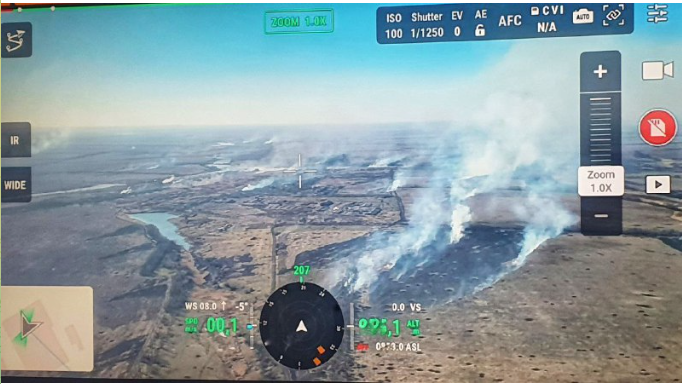 [1]
[1]
by John Helmer, Moscow
@bears_with [2]
The collapse of the Ukrainian army following the battle of Avdeyevka, and its disorganized retreat, have accelerated Russian military thinking of how far westward the NATO allies will decide that the Ukrainian statelet can be defended against the expected Russian advance – and how fast new NATO defences can be created without the protection of ground-to-air missile batteries like Patriot, long-range artillery like the M777, and mobile armour like the Abrams, Bradley, and Caesar: all of them have already been defeated in the east.
In short, there is no longer a NATO-command line of fortification east of the Polish border which deters the Russian General Staff. Also, no bunker for the Zelensky government and its NATO advisors to feel secure.
Cutting and pasting from the Russian military bloggers and the Moscow analytical media, as a handful of US podcasters and substackers are doing as often as their subscribers require, is the Comfy-Armchair method for getting at the truth [3]. Reading the Russian sources directly, with the understanding that they are reporting what their military and intelligence sources are saying off the record, is still armchair generalship, but less comfy, more credible.
Offence is now the order of the day up and down the contact line. The daily bulletin from the Ministry of Defense in Moscow calls this “improving the tactical situation” and “taking more advantageous positions”. In the past three days, Monday through Wednesday, the Defense Ministry also reported the daily casualty rate of the Ukrainian forces at 1,175, 1,065, and 695, respectively; three M777 howitzer hits; and the first Abrams tank to be destroyed [4]. Because this source is blocked in several of the NATO states, the Russian military bloggers, which reproduce the bulletins along with videoclips and maps, may be more accessible; also more swiftly than the US-based podcasters and substackers can keep up.
Moscow sources confirm the obvious: the operational objective is to apply more and more pressure at more and more points along the line, in as many sectors or salients (“directions” is the Russian term) as possible simultaneously. At the same time, air attack, plus missiles and drones, are striking all rear Ukrainian and NATO airfield, road, and rail nodes, ammunition storages, vehicle parks, drone manufactories, fuel dumps, and other supply infrastructure, so as make reinforcement and redeployment more difficult and perilous.
What cannot be seen are the Russian concentrations of forces aimed in the north, centre and south of the battlefield. Instead, there is what one source calls “an educated guess is that when the main blow comes, it will be North, Chernigov, Sumy, Kharkov, Poltava, or Centre, Dniepropetrovsk, Zaporozhye, or both simultaneously.” For timing, the source adds, “after the Russian election.”
That is now less than three weeks away, on March 17. President Vladimir Putin will then reform his new government within four to six weeks for announcement by early May. Ministerial appointments sensitive to the General Staff’s planning are the Defense Minister Sergei Shoigu, who is expected to remain in place; and the Foreign Minister Sergei Lavrov, who may retire.
Following the call of French President Emmanuel Macron for the “possibility” of French ground force deployment to the Ukraine battlefield, and the subsequent clarification by French Defense Minister Sébastien Lecornu, the Russian assessment has been derisory. “As for Emmanuel Macron’s statements about the possibility of sending NATO troops to Ukraine,” replied [5]Foreign Ministry spokesman Maria Zakharova, “I would like to remind you that just a month ago, the French Foreign Minister denied Paris’s involvement in recruiting mercenaries for the Kiev regime, and called direct evidence ‘crude Russian propaganda.’ There is a strong impression that the French President is, in principle, not aware of what his subordinates say, or what he says himself. And now I want to remind Macron of the history of France. That is different. In April 1945, Berlin was defended by the French SS division known as Charlemagne, and a number of others. They also directly defended the Fuhrerbunker — Hitler’s bunker. They were among the last to be awarded the Nazi Order of the Knight’s Cross in the Third Reich. The French SS men from Charlemagne became the last defenders of the Reichstag and the Reich Chancellery. Emmanuel, have you decided to organize the Charlemagne II division to defend Zelensky’s bunker?”
The view in Moscow is that there is now as much indecision, vacillation, and chaos between the Elysée and the Hexagon Balard [6] in Paris as there is in Washington between the White House and the Pentagon, over what last stand NATO can make in the Ukraine, and where to position it — east of Kiev, or east of Lvov and the Polish border region.
The Moscow source again: “the NATO fortress and bunker plan for the Ukraine is proving a failure, and the Ukrainians are falling back on the old Wehrmacht tactic of ad hoc battlegroups with increasing percentages of unit leftovers and low-quality conscripts acting as fire brigades to plug holes in the lines so as to delay the Russian advances. But what is the bunker fallback plan along what lines – is the plan to wait until the Americans, French, Germans or Poles show up? This is the stuff of Nazi dreams. It’s too late.”
A western military source comments: “I’m not so sure, as some of the Russian milbloggers are, that the broad front approach [Russian General Valery] Gerasimov is taking heralds a new approach to modern warfare – or operational art, if you like. The push at different points, conserving men and materiel in favour of firepower is being done as much, or more out of political considerations, which include those of a domestic character (Putin’s public support, domestic stability); and also the military objective since Day One of the Special Military Operation — to draw in and destroy as many and as much of the US-NATO manpower and equipment in the Ukraine as possible.”
“The Russian ‘retreat’ conducted in Fall of 2022 was part of the plan and struck me as being inspired by the Mongol tactic of attacking, making a big show of running away, only to turn to pursue and then destroy the enemy. The Ukrainians and their NATO handlers fell for it hook, line and sinker. Now they don’t have the forces needed to maintain their fortress strategy, let alone conduct much in the way of counter-attacks. It was in this fashion that Gerasimov gained the upper hand in the two-front war – the one on the Ukrainian battlefield and the one on the Russian home front.”
“Deep battle is still the Russian doctrine. Its form and components may change, but the concept remains the same. The art is in figuring out where and when the holes drilled in the other side’s military, economic, and political structures will line up, and present the path to be exploited by Gerasimov. We can bet he’s known for quite some time.”
Two translations follow of current Russian military analyses. The first is by Boris Rozhin, whose Colonel Cassad Telegram platform is one of the leading military blogs in Moscow. The second is by Yevgeny Krutikov who publishes long pieces in Vzglyad, the semi-official security analysis medium in Moscow, and short pieces in his Telegram account, Mudraya Ptitsa [7] (“Wise Bird”).
The translation is verbatim and unedited. Maps and illustrations have been added.
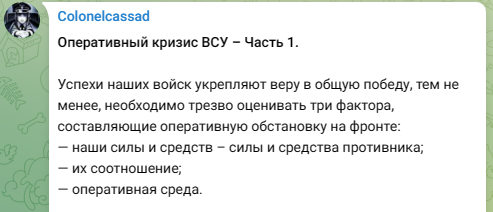 [8]
[8]Source: https://t.me/s/boris_rozhin [9] -- posted on February 27, 2024 – 20:25. Part II has not been published yet.
February 27, 2024
The operational crisis of the Armed Forces of the Ukraine – Part 1
By Boris Rozhin (“Colonel Cassad”)
The successes of our troops strengthen faith in a collective victory. However, it is necessary to soberly assess the three factors that make up the operational situation at the front:
— our forces and materiel – the forces and materiel of the enemy;
— the ratio between them;
— the operational environment.
The situation in which the enemy is now on the defensive can be called an operational crisis. For four months, the Armed Forces of the Ukraine [VSU is the Russian acronym] command concentrated their reserves in Avdeyevka and Chas Yar, weakening other sectors of the front (in particular, Kupyansk and Zaporozhye). Having failed to ensure a crucial preponderance of forces, against the background of an increase in the media importance of Avdeyevka, the enemy lost the operational initiative and is now forced to withdraw to reserve linesof defence. But they are not fully operational.
The transfer of reserves of the VSU is carried out under the increasing attacks of our aviation and high-precision attacks on key railway nodes (for example, Pokrovsk and Konstantinovka). Many VSU units need to be withdrawn for reformation, which is currently impossible. Therefore, they are equipped at the expense of mobilized citizens with low motivation and combat training.
LARGE MAP OF OPERATIONS AS OF FEBRUARY 28, 2024
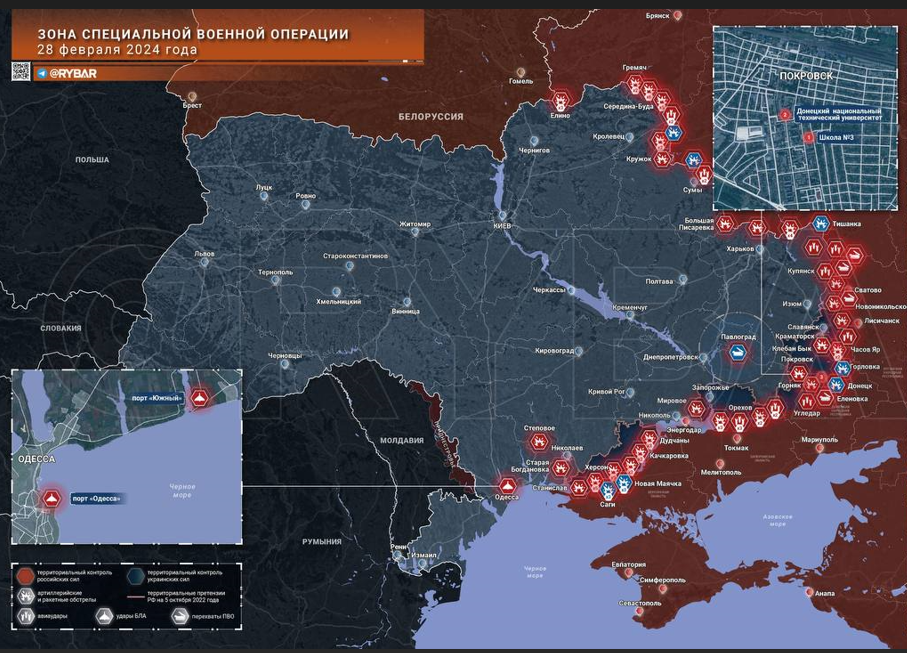 [11]
[11]Source: Rybar. Click on original to enlarge view: https://t.me/s/rybar [12] -- February 29 00:42.
By developing an offensive initiative west of Avdeyevka, our units have deprived the enemy of the opportunity to gain a foothold there. According to the Bakhmut scenario in the summer of 2023, when attacking near Kleshcheyevka and Berkhovka, the VSU created a hotbed of tension, forcing us to hold large forces in position. Today, the Armed Forces of Ukraine do not have the opportunity to fully regroup, so they are withdrawing troops in key operational areas: Zaporozhye (Orekhov) and Slavyansk-Kramatorsk (taking into account our positions in the Avdeyevka and Bakhmut initial areas).
The new [VSU] commander-in-chief, [General Alexander] Syrsky, is confused about exactly where to concentrate his forces. In conditions of simultaneous movement of our formations along the entire front line: in the Zaporozhye, Donetsk, Lugansk (the Svatovo-Kremennaya line) and Kupyansk operational directions, the concentration of forces and materiel in a particular area will inevitably create conditions for a breakthrough of the Ukrainian defence.
The advance of the Armed Forces of the Russian Federation in the Maryinsk-Ugledar operational and tactical direction and in the area of Novomikhailovka creates conditions for squeezing the enemy west of the Marinka-Ugledar highway and in the direction of Kurakhovo, which in the foreseeable future will become a key node in the VSU defence in this area. The situation is developing in a similar way in the Konstantinovsky direction, where our troops are having success at Chas Yar, advancing at the moment with coverage to Ivanovskoye, the largest defensive line in front of the Chas–Yar fortress area.
MAP OF THE CHAS YAR OPERATIONS AS OF FEBRUARY 28, 2024
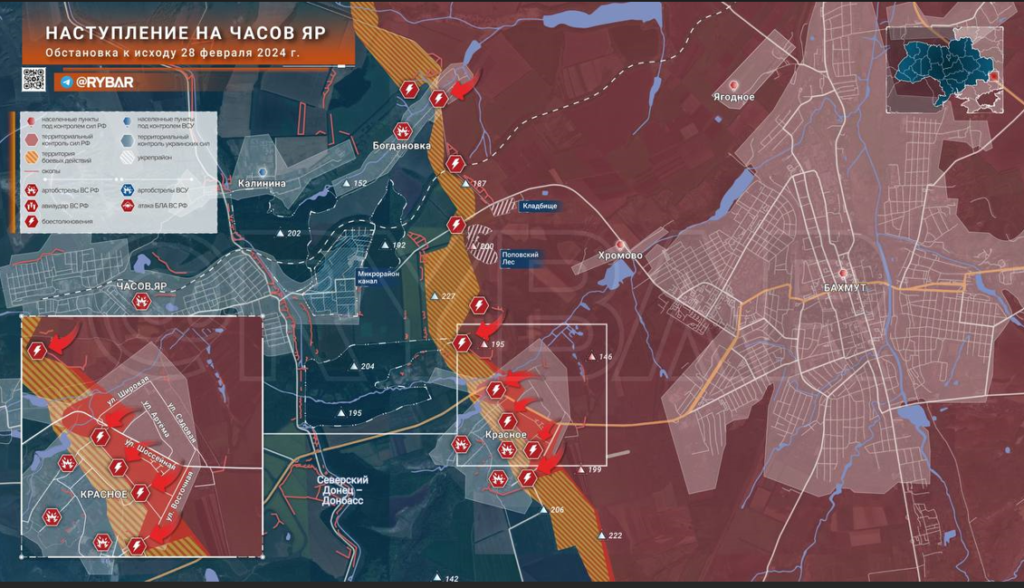 [13]
[13]Source: Rybar. Click on the original to enlarge view: https://t.me/rybar/57610 [14]
Steady pressure is recorded in the area of Yampolovka and Ternov, the Serebryansky forest, as well as on the left bank of the Seversky Donets, where an offensive is underway against Belogorovka in order to reach Seversk. Positional battles continue south of Seversk in the Razdolovka–Veseloe strip. Our units are moving along the railway line, although the tactical conditions of the terrain are not conducive to a rapid offensive there. The situation is more complicated in the Kupyansk direction. However, despite the difficulties of advancing and the altitude differences, we are managing to contain large enemy forces on both banks of the Oskol.
A likely scenario for the development of the situation is that during the coming month the VSU will continue the gradual withdrawal of troops to new lines along a rear echelon from 15 to 20 kilometres back, while simultaneously trying to engage us in battles in areas where terrain conditions and defensive fortifications will allow us to hold positions: these are Chas Yar–Konstantinovka, the southern approaches to Seversk (Rayaleksandrovsky fortress area), the Marinka– Kurakhovo–Ugledar line (Donetsk direction), and Rabodino–Orekhov (Zaporozhye).
At the moment of withdrawal from a particular area, the enemy will transfer his forces from site to site in order to inflict maximum damage to our advancing group. The VSU does not consider any other option, for example, to counterattack, since the concentration of troops required for that risks taking the shape of the Avdeyevka scenario, with the real prospect of falling into a котёл [trap].
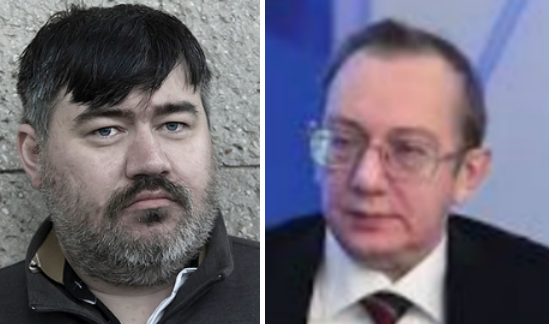 [16]
[16] Left, Boris Rozhin; right, Yevgeny Krutikov.
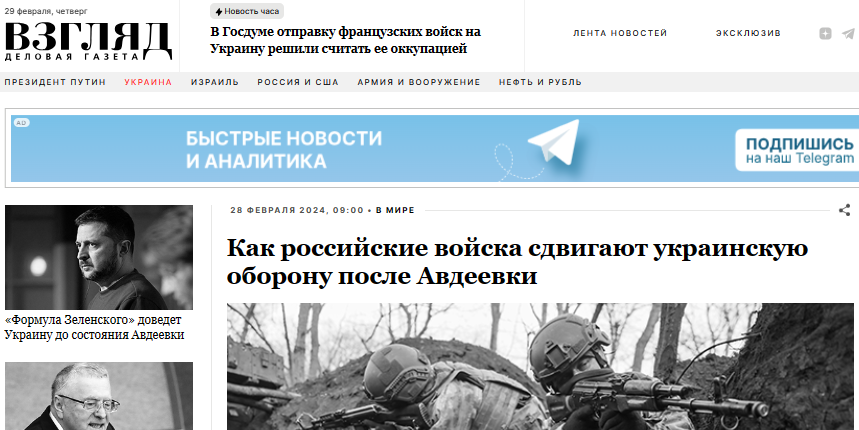 [17]
[17]Source: https://vz.ru/ [18]
February 28, 2024
How Russian troops are shifting Ukrainian defenses after
Avdeyevka
By Yevgeny Krutikov
The advance of Russian troops to the West after the liberation of Avdeyevka has not been stopped at all. The Armed Forces of Ukraine have not been able to gain a foothold on any defensive line for many days, and moreover, this applies not only to the Avdeyevka direction. What is happening on the line of contact in the special operation zone and what will be the target of the Russian army in the coming weeks?
After the liberation of Avdeyevka the units of the Russian Armed Forces maintained a high rate of advance in this section of the line of contact. The enemy hastily tried to create new lines of defence to the west of the city along the Stepovoye–Berdych-Orlovka–Lastochkino–Tonenkoe–Severnoye line. But by Tuesday, February 27, Russian assault units had occupied the first line (Stepovoye, Lastochkino, Severnoye) and began operations to occupy the second line.
In some instances the enemy simply abandoned their positions, unable to withstand the blows of bombs and assault actions. The open spaces (fields, forests, and gullies) west of Avdeyevka came under the control of the Armed Forces of the Russian Federation almost without a fight.
There is an explanation for this. First of all, the organization of defence on new frontlines is extremely costly and time–consuming; it requires a huge amount of equipment and specialists, and most importantly, time. It is precisely this time which the Russian troops are seizing to consolidate their positions, denying them to the Armed Forces of Ukraine, and constantly putting pressure on them, primarily with long-range weapons.
The VSU, as it now turns out, were not prepared at all for the rapid abandonment of Avdeyevka. In addition, it seems that the enemy cannot withstand a direct clash with Russian troops outside of positions they have fortified in advance. The VSU can cling to long-term fortified areas which have been prepared for a long time, but with the constant pace of the Russian offensive, they are forced to withdraw even from these positions.
Behind the new line of defence of the Armed Forces of Ukraine, which has developed in the Avdeyevka area at the moment (provisionally around Orlovka), an empty space has opened up in which there are no natural obstacles capable of supporting new defensive fortifications. There is nothing like this up to the next major settlements of the Donbass, primarily Krasnoarmeysk (Pokrovsky). The enemy has not strengthened the small villages there in any way, thinking it wouldn’t be necessary.
MAP OF AVDEYEVKA AREA OPERATIONS AS OF FEBRUARY 28, 2024
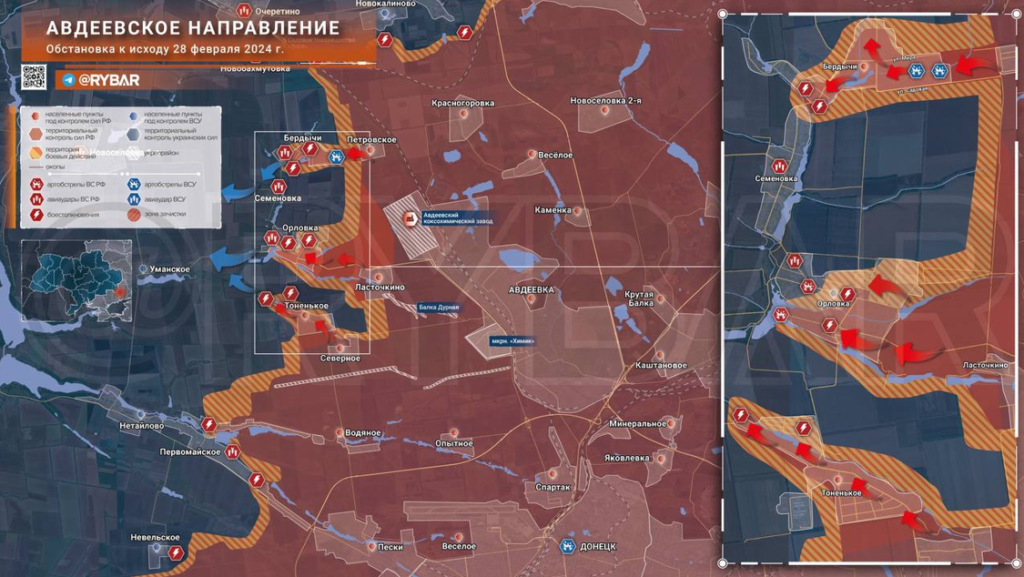 [20]
[20]Source: Rybar. Click on original to enlarge view: https://t.me/rybar/57677 [21]
The only limitation on the Russian forces for moving forward in this direction may be the old positions of the VSU on the flanks. For example, Kurakhovo is planned to be another “fortress”, which by the very fact of its existence creates a flank threat to the advance of the Avdeyevka grouping of the Russian forces.
The situation in another section of the contact line, west of Artemovsk, is indicative in this regard. The enemy’s positions in front of Chasov Yar in the villages of Krasnoe (Ivanovskoye) and Bogdanovka have looked to be very strong. But the Armed Forces of the Russian Federation began to move there not head-on, but from the north, pushing through and bypassing the fortified areas of the VSU. As a result, by Tuesday, the assault groups had advanced almost to the centre of the village. At the same time, several heights were occupied, opening the way further to the west.
This manoeuvre is clearly visible on satellite images of the area where the lines of the enemy’s trenches south of Krasnoe are visible. Apparently, the VSU was afraid of the movement of Russian attack aircraft from this direction, from Kleshcheyevka. The ruins of Kleshcheyevka themselves are practically surrounded at the moment, but this direction has become secondary to movement on Chasov Yar.
The first districts of Chasov Yar – east of the canal, where the VSU units are located – are now being constantly shelled by Russian artillery and bombs [ФАБ] [22], which make it impossible for the enemy to manoeuvre their reserves and rotate.
The enemy transferred most of the reserves available at the beginning of February to Kupyansk. In Kiev this stabilization of the front near Kupyansk is considered a great achievement. The Kiev command is motivated to hang stubbornly on to the zone around Kupyansk by the realization that if they lose this node, that would lead to the redeployment of parts of the Russian forces all the way up to Kharkov.
But the most important thing that the intelligence and leadership of the VSU are currently doing is trying to determine where the new main blow of the Russian offensive will occur after Avdeyevka. The fact is that the Russian armed forces are now maintaining an operational pace along the entire line of contact. There is no section of the front line where successful assault operations would not be noted. This “multiple bites” [множества укусов] strategy currently being undertaken by the Russian forces has led to the disorganization of enemy behaviour and the dispersion of its resources.
For example, the first assault detachments of the Armed Forces of the Russian Federation on Tuesday night already entered the settlement of Terny in the Limansky direction and gained a foothold in it. The movement to Terny had not halted even for a day over several weeks, remaining in the shadow of the larger-scale events in the Avdeyevka direction and around Rabocino. But all of a sudden now it has turned out that in this area, units of the Armed Forces of the Russian Federation have entered completely new positions, threatening to move further west to the Liman and looming over the enemy’s Seversk grouping.
In Kiev, there is a well-founded fear that these new landmark breakthroughs by Russian units may generally lead to the collapse of Ukrainian defence and the transition of military operations to the more western regions of Ukraine.
Moreover, almost the entire line of contact, except for the Chasov Yar area, is now so fragmented that the Armed Forces of the Russian Federation have the opportunity to enter the operational space in several directions at once. Even the western press is now actively writing that the Russian forces are capable of providing assault operations simultaneously in two or three areas. No one knows which one of them will end up being the main one.
It is possible that there will be no “main” direction of impact, at least in the classical understanding of this concept. The new military reality also offered by the Armed Forces of the Russian Federation is a novel tactic: the movement of small assault groups with powerful support from artillery and heavy aerial bombs. Thus, the occupation of enemy strongholds is ensured, and only then are large open spaces cleared with the help of tanks.
In other words, relatively large settlements, turned into strongholds by the enemy, become something like a general direction, a vector of movement. For example, Pokrovskoye (Krasnoarmeysk) is located 40 kilometres west of Avdeyevka. This is clearly the next target for Russian troops. But the movement towards this goal need not be direct, but may be guided by the requirement to bypass and destroy the enemy’s defence lines.
At Chasov Yar, movement that was not in a straight line turned out to be effective for the Russian forces, bypassing from the flanks the enemy’s fortified areas south of Krasny. Operations to hold down the enemy are conducted in Kupyansk in a straight line, while unexpected assault actions on the outskirts of this section of the front (the same Terny) lead to new threats of the encirclement of the defending units of the VSU.
Perhaps in the coming days we will see the next offensive operations of the Russian forces according to a linear scheme: the encirclement of Kurakhovo through the occupation of Krasnogorovka, access to the heights south of Chasov Yar, movement to Seversk, access to the supply lines of Ugledar, forcing the channel in Terny, breaking the enemy’s defences west of Avdeyevka, and much more.
None of these areas will be the “chief” or “main” one, but each of them will create the preconditions for the further liberation of the Donbass.
[*] The lead picture is reproduced [24] by Boris Rozhin to illustrate his battlefield report of February 28, at 19:17, indicating the disorganized retreat of Ukrainian forces west and south along the Berdych-Orlovka-Tonenkoe line in the central sector. “Today, the enemy has actually lost this line. Orlovka is in the process of coming under the control of Russian troops. In the next 24 hours, we should expect the appearance of videos with flags in Orlovka. Berdych is next. An advantageous and prepared line of defence did not last long. The enemy will retreat to the west with subsequent attempts to use natural water barriers and terrain to compensate for the lack of prepared engineering structures.”



